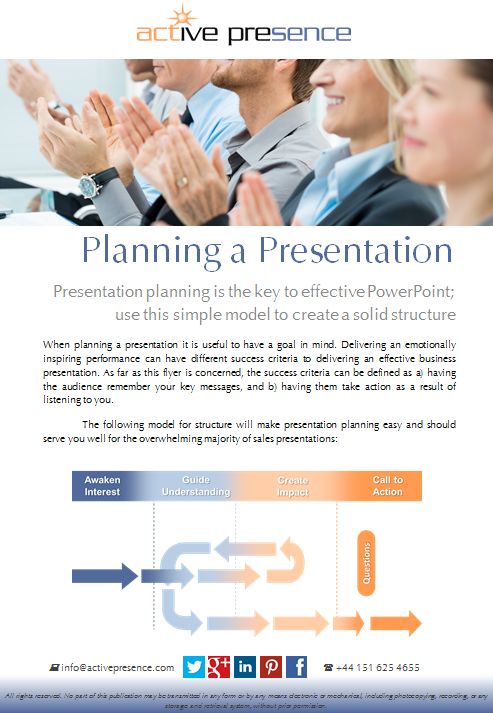Planning A Presentation
Presentation planning is the key to effective PowerPoint; use this simple model to create a solid structure when planning a presentation
Before you start to plan and structure your presentation it is useful to have a goal in mind. Delivering an emotionally inspiring performance can have different success criteria to delivering an effective business presentation. As far as this flyer is concerned, the success criteria can be defined as a) having the audience remember your key messages, and b) having them take action as a result of listening to you.
The following model for structure is simple and will serve you well for the overwhelming majority of sales presentations:
Awaken Interest: Whatever the presentation, make sure that you have an opening that awakens your audience’s interest. Commit this section to memory, so that you can deliver it on automatic pilot. It doesn't need to be long, around 200 to 250 words is fine. It’s important to note that it’s not a run through of the agenda. This is boring – like reading the contents page of a book. Your awakening interest statement should be more like the opening couple of paragraphs of a good thriller, or the teaser text on the back cover of a paperback novel.
Guide Understanding and Create Impact: Once you've hooked your audience with your engaging opening, you can focus on the material you want to cover. As you take your audience through your material, there will be natural points at which you want to deliver a key message. Create some impact at these points by telling a story that directly relates to that key message. A well told story will be remembered by the audience, long after the detail of the presentation has faded. If your stories are associated with your key messages, then they'll also be remembered too.
Call to Action and Questions: it's important that your call to action is the last phrase your audience hears you deliver. In the diagram you'll notice that the classic Q&A session occurs prior to the call to action. This is important and something that is often overlooked. Typically, the speaker will finish his or her presentation and then ask, "Are there any questions?" This is exactly the wrong thing to do. Here’s why:
• It hands control of the presentation to the audience – never a good thing. (Engaging an audience is not the same as relinquishing control to them)
• As a direct result of the above point, there is a good chance that the last voice the audience hears is not your voice, but that of a third party
• The audience is more likely to remember the last thing they heard – and it may well not have been your call to action. In other words, your presentation has effectively been wasted

